There’s no denying it, hydrangeas are seemingly miraculous.
Their eye-catching blossoms (technically an inflorescence) come in a range of colors, from deep purple to bright pink, and icy blue to pale lavender. There are also varieties with white or green blooms.
Their display is so splendid that you might find it particularly upsetting when they fail to send out their distinct flowers.

We link to vendors to help you find relevant products. If you buy from one of our links, we may earn a commission.
Don’t get me wrong, I love my spireas too, for example. But after they stayed bloom-less thanks to a pruning mishap one year, I didn’t feel the same sense of loss that I did when my ‘You and Me Together’ hydrangea sat bare for a season.
Let’s face it: hydrangeas can be fussy about temperature, light, and moisture, and some work is required on the part of the gardener to help them to be as beautiful as they possibly can.
But once you know what’s going on, most issues are easy to address.
As discussed in our guide to growing hydrangeas, these shrubs fall broadly into five categories: climbing (H. petiolaris), smooth (H. arborescens), panicle aka peegee (H. paniculata), oakleaf (H. quercifolia), and bigleaf (H. macrophylla).
Bigleaf, also known as French hydrangea (though this species originally comes from Japan), is the species that gardeners experience problems with most often when it comes to a lack of blossoms.
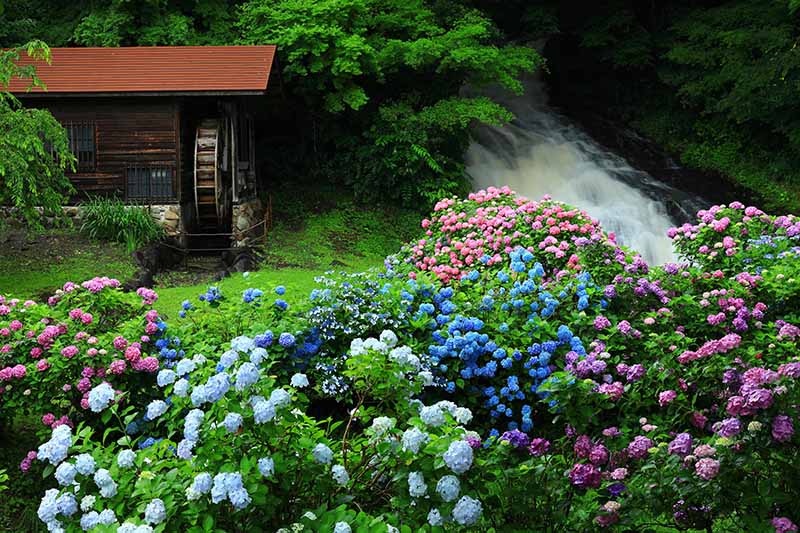
Many bigleaf and oakleaf cultivars only flower on old wood, that which was produced in the previous summer or earlier. New wood, on the other hand, is that which emerges in the current growing season.
This blooming habit can have an impact on whether or not a plant will send out blossoms. If something happens to the old wood as it’s sending out the buds that will eventually turn into flowers, you won’t get a floral display that year.
But it isn’t just plants that bloom on old wood that can fail to flower. Up ahead, we’ll discuss seven of the most common issues you may run across and how to tackle them.
Ready to jump in?
7 Reasons Why Hydrangeas May Fail to Bloom
1. Hungry Deer
According to information provided by the New Jersey Agricultural Experiment Station at Rutgers University, which works with experts to rate the deer tolerance of various plants, all groupings of hydrangeas, from bigleaf to climbing, are “occasionally severely damaged” by deer.
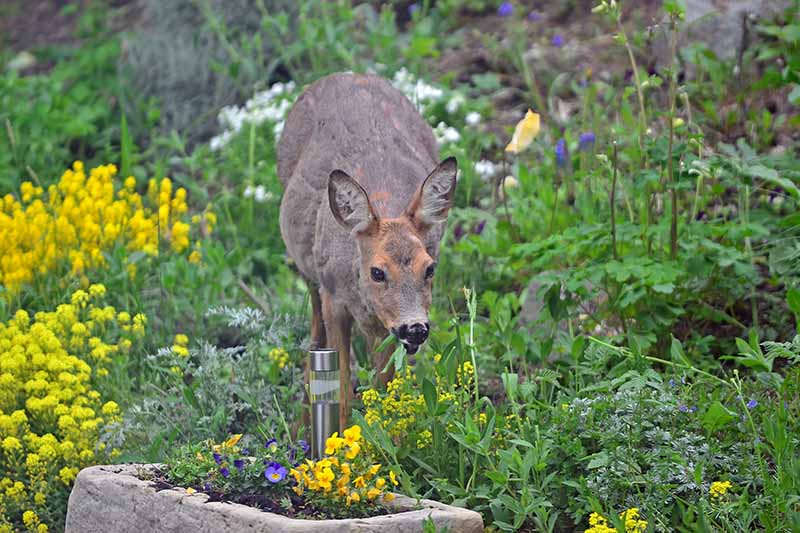
That means these plants are “often preferred” by deer looking for something to eat. So what does this have to do with the fact that you’re not seeing the flowers you want to see?
The common concern is that the deer might eat the buds on the old wood during the fall, winter, or spring. If you have a plant that only blooms on old wood and that happens, you won’t have blossoms the following summer.
If your plant has a few blossoms here and there that look perfectly healthy, but overall the number of blooms is reduced, it’s possible that deer nibbled some but not all of the buds.
Deer are notorious for just browsing a few branches here and there before moving on to another plant.
So how do you identify deer damage versus damage caused by other types of pests? Assuming you don’t see the animals themselves, look for their tell-tale eating habits.
Deer rip the leaves off a plant, so you’ll see evidence of tearing, like ragged edges on leaves and torn stems.
They also tend to eat young green wood, buds, and leaves, and avoid the petioles (the stems of the leaves) and brown wood.
The solution is, of course, to keep marauding ungulates out of your garden. Fencing works best, and our guide to deer fencing has you covered if you need some help constructing your barrier.
You can also wrap plants in burlap, which has the added benefit of protecting them from extreme cold, another culprit that may result in failure to bloom.
Learn more about this below in the section on harsh winters.
2. Excess Nitrogen
Any flowering plant that is given too much nitrogen fertilizer may put too much energy into growing its foliage, at the expense of its flowers.
Nitrogen is one of the primary nutrients that plants need to survive. They use it to form new leaves and support existing foliage.
Phosphorus, another one of the necessary main nutrients, is utilized by plants to make new roots, seeds, fruit, and flowers.
If hydrangeas are fed more nitrogen than potassium, they may skip flowering and grow more foliage instead, and leaves that are larger.
If you aren’t sure whether nitrogen is causing the issue or not, test your soil.
I think everyone should do this once a year regardless of whether or not they’re seeing problems, but a soil test will tell you for sure if nitrogen is causing your blossom woes.
Miracle-Gro Water Soluble Bloom Booster Flower Food
The solution is to use a slow-release fertilizer with a higher amount of phosphorus than nitrogen.
Look for a product that is labeled for use to encourage flowering, like Miracle-Gro Water Soluble Bloom Booster Flower Food, available via Home Depot.
3. Harsh Winters
With bigleaf cultivars that only bloom on old wood, a harsh winter can cause the plant not to flower the following year.
This species is usually cold hardy to Zone 6, though there are a few exceptions. If you have a particularly nasty winter, you might want to provide some protection.
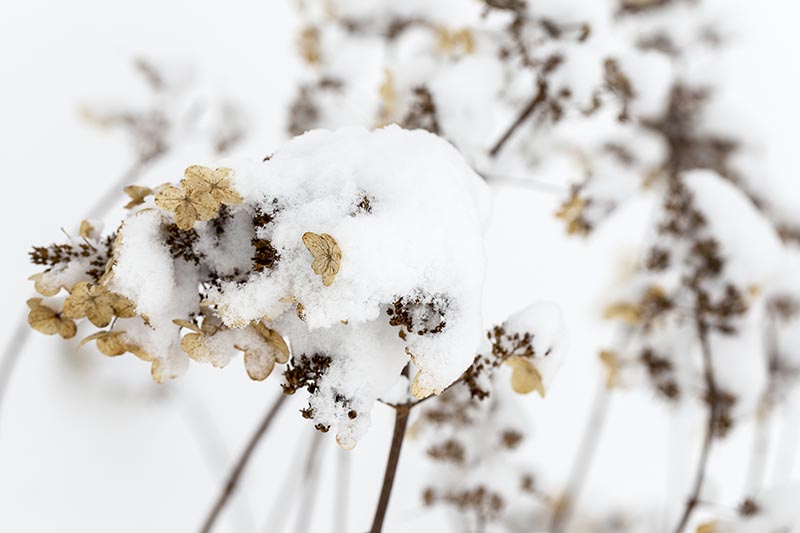
That’s because the buds that will turn into flowers form on old wood starting in the fall, but if there is a frigid winter, it can kill those developing buds. Anything below 5°F can be a problem.
Even though oakleaf hydrangea also forms blooms on old wood, these are more cold hardy and don’t usually suffer from this issue.
To protect plants in the winter, wrap them in several layers of burlap and secure the material in place with some twine. You can leave them under cover for the entire winter or just protect them during cold snaps.
Remove the burlap once low air temperatures are consistently 15°F or higher.
4. Not Enough Water
All types of hydrangeas like a good amount of moisture, with consistently moist soil. If yours is consistently drying out, your plants might not bloom.
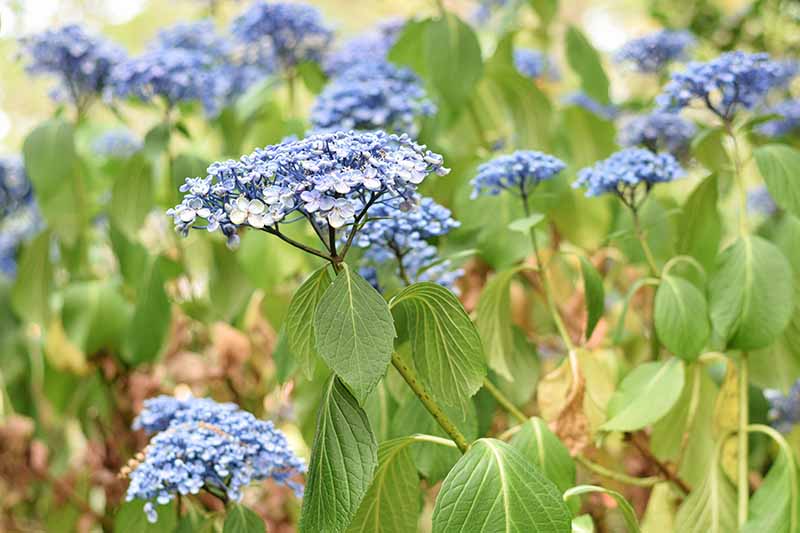
Plants in the bigleaf species might need to be watered every other day if you live in a hot and dry climate.
These plants need about two inches of water per week, so if you aren’t getting enough rain, you’ll need to provide supplementary irrigation.
A rain gauge can help you figure out how much moisture your plants are receiving from Mother Nature so that you can supplement with the rest.
Other species aren’t so fickle, but keep an eye on them to ensure they have enough water.
If the leaves start to droop and wilt, especially in the heat of the day, this is a sign that they aren’t receiving the quantity of water that they want.
5. Pruning Problems
Pruning is one of the most common contributors to a lack of blossoms. If you prune any time from autumn to late spring, you might be cutting off the growth on the old wood that would have turned into flowers.

So when exactly should you prune to avoid this problem? Do it in the summer, after the flowers have faded but before the fall hits. That leaves a small window for cutting your plant back if you want a showy display in the spring.
There’s one exception to this: you should prune off dead branches in the spring, back to the point of live growth. Dead wood is dry, snaps when you bend it, and won’t have any visible new growth.
You can also deadhead flowers after they have faded, or just leave them on the plant. If you decide to deadhead, snip the flower heads off above the first set of leaves.
If all of this seems too intimidating, don’t prune your bigleaf or oakleaf plants at all!
Also keep in mind that you aren’t the only one who might be pruning at the wrong time. As I mentioned above, deer might nibble on that fresh growth, essentially pruning it for you.
There are also cultivars out there that bloom on both old and new wood, such those in the Let’s Dance®, Endless Summer®, and Seaside Serenade® series. You won’t have to worry about this problem if you plant these.
Everlasting® ‘Revolution’ is another such option that grows best in Zones 5-9.
Plants are available from Burpee.
6. Too Much Shade
Hydrangeas grow well in partial shade, but too much of it and they won’t flower.
While these plants traditionally grow wild in the understory of forests, they still receive some dappled sun in their natural habitat. If yours is planted in a spot where it isn’t receiving enough sun, you won’t see blossoms.
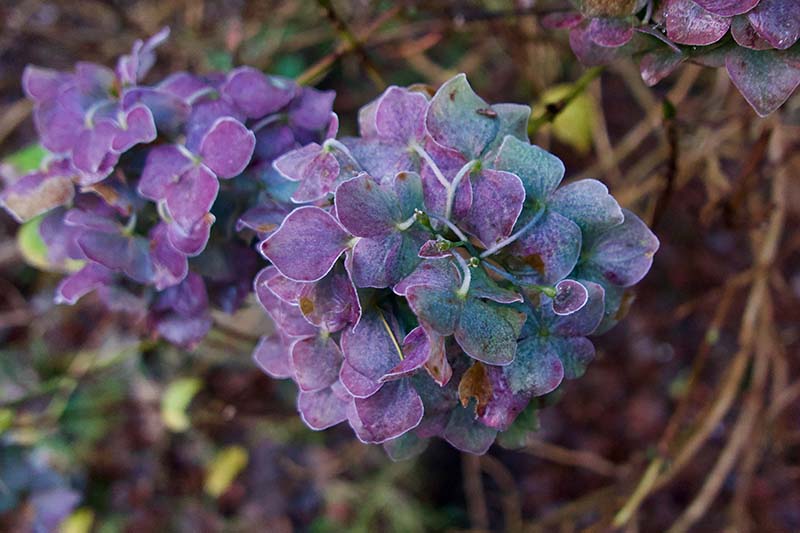
This is often a problem when a gardener plants their hydrangea under some trees that aren’t fully mature. As those trees grow and fill out, they block more and more sunlight from reaching the ground.
It’s easy to fail to notice this problem developing because it happens so gradually. Then, one year when your plant doesn’t send out those lovely flowers, you suddenly realize that its location has gotten shadier over time.
That isn’t the only situation that can reduce the amount of light your plants get. You might also have had a particularly cloudy spring.
If your hydrangea was blooming well in the years prior and stopped this year, check the amount of sun that’s reaching it. You can even use a meter to help you get an accurate picture.
This Active Air 3-Way Meter from Arbico Organics measures moisture, light, and soil pH, so you can see what’s going on with your planting area.
If you planted your hydrangea within the last year or two, double-check to make sure it is receiving about three hours of sun, preferably in the morning, with protection from the afternoon rays.
Panicle types in particular need a fair amount of sun to bloom. They can even handle full sun in many climates. Oakleafs may do well in deeper shade in some zones.
7. Too Much Sun
On the other hand, too much sun can also be a problem. A plant that is hit with more sun than it likes becomes stressed, and a stressed plant may decide to skip blooming to conserve energy.
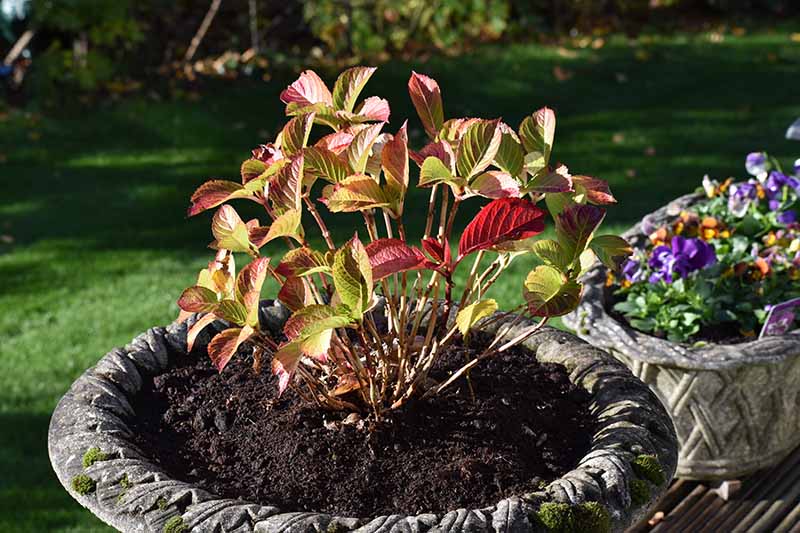
H. paniculata can handle full sun, but H. macrophylla needs part shade to thrive, especially in hot regions like Zones 8 and 9. In cooler regions, like Zones 5-7, they can be in full sun.
Again, as with too much shade, you can use a meter to determine how much light your plants receive. Also, check on them in the afternoon to see if they are looking wilted.
If you see leaf scorching, this is a sure sign that your plant isn’t in the right spot. Look for yellowing and browning on the edges and tips of the leaves.
Bring Back Those Beautiful Blossoms
If you just planted a new plant and you aren’t seeing blooms in the first year or two, don’t worry.
New plants tend to focus energy on establishing roots and developing healthy foliage before they try to reproduce, or in other words, make flowers.
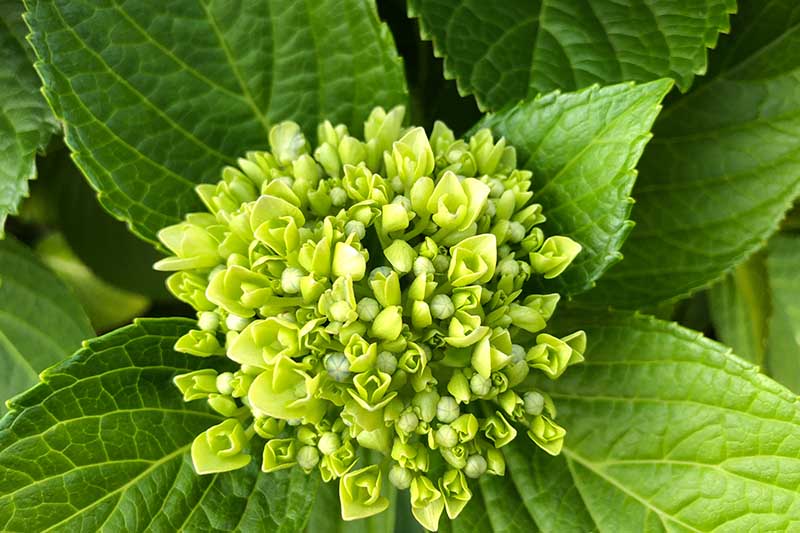
If that’s the case, just give your plants some time and ensure that you’re providing the food and water they need to support their efforts. But if an established hydrangea suddenly stops blooming, this list should help you get things back on track.
Let us know which fix makes your hydrangea bloom again, and share your questions in the comments section below so we can help other readers solve their blossoming woes!
And for more information about growing hydrangeas in your garden, check out these guides next:
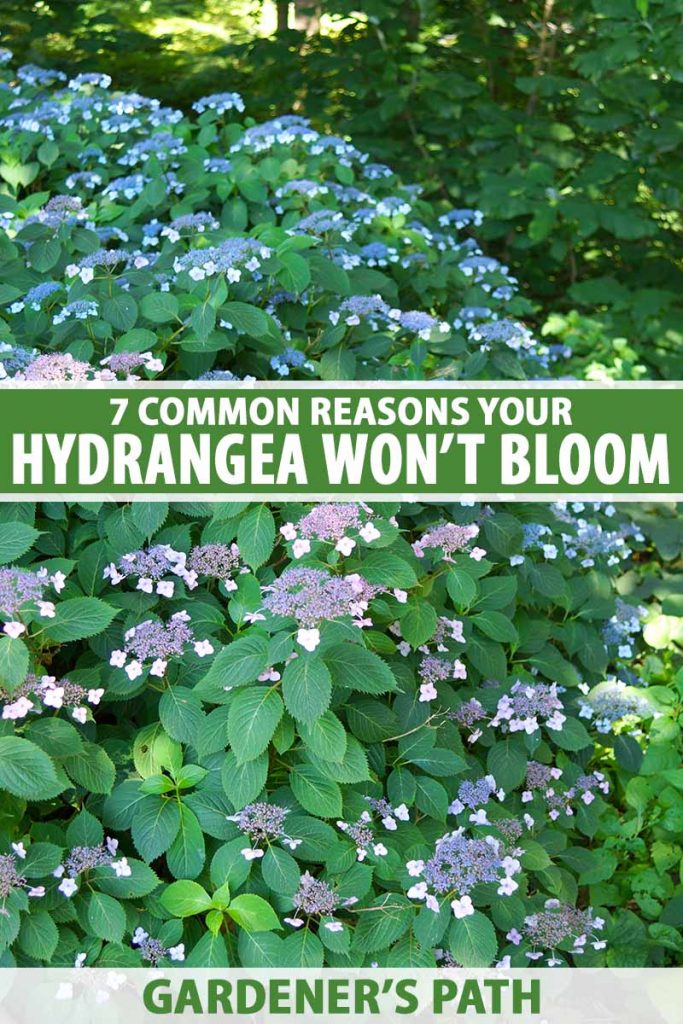
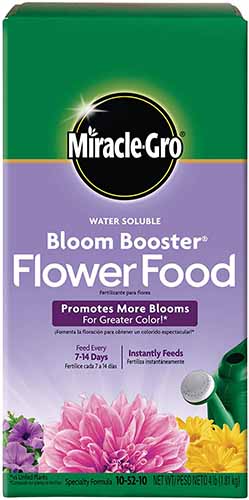



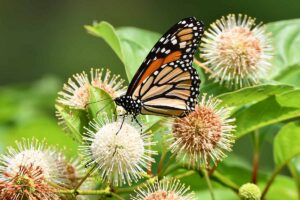
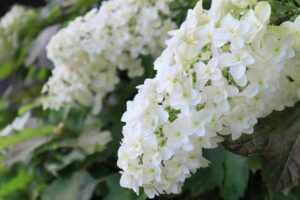
I had this problem. What worked for me was to plant the bushes in a partial shade and partial sun place. They bloomed this year, but the flowers are small. What could be the issue there? Thanks.
It depends on the kind of hydrangeas you are growing. I would suspect a pruning issue, but it could also be some sort of deficiency in the soil. Start with a soil test and let me know what kind of hydrangeas you are growing so we can see if pruning is the problem.
I have 3 hydrangeas In 22×4 foot bed. All get approximately same amount of sun. I did not cut any of them back. Middle one has at least 4 dozen blooms. Others have 0. Can’t find a reason. Help!
I have the same problem. I have 2 hydrangeas planted 6 feet apart about 3 years ago. One blooms beautifully, the other has healthy green leaves, but it has never bloomed. Can plants be sterile?
If all of the plants are getting the same sun exposure and the same fertilizer, the next thing to look at is water. If you are using sprinklers, it could be that one plant is getting all the water and blocking the others. If you pruned them all at the same time, is it possible that wandering deer may have nibbled the buds off some of the plants but not all of them?
[email protected]
I am a beginner and was given an hydrangeas plant in memory of my late mum. It grew beautifully last summer but I fear I have done damage to my plant since planting in the ground. I have watered it but can it be saved?
My best guess is that this plant is dead. That said, I would keep watering it and see if new shoots come up out of the ground. Never say never!
Absolutely. I work at a nursery and so many times have coworkers been piling up plants, including the beautiful hydrangea! I saw potential though. Ya know, the snap test or scratch test on the branches. Good thing I saved those puppies bc man did they grow back in spades. Not once have I thrown out a plant whose roots were in decent shape. (I like to snoop around down there too). And it always pays off
Hello, I have 2 hydrangeas that have blooms but it is really hot this week. They get shade after 3 but some of the leaves burned on one and the other has some yellow leaves and the leaves are more sparse.i was wondering if I gave to much water to the incredible blush hydrangea. It has been a scorching 90 in full blazing sun
Its more likely that the burning, yellowing, and sparseness is from the heat. Use a moisture meter or stick your finger in the soil and see if it feels like a well wrung-out sponge. That’s the level of moisture you want to aim for, especially during hot spells. If it feels soggy or wet, then you’ll want to back off of the water a little.
My hydrangeas were planted last year. I have green leaves but not a single flower. I have heard they skip a year of blooming sometimes.
Are you fertilizing? Flowers can be sparse on new plants until they become established, but an overabundance of nitrogen can also support the growth of foliage at the expense of blooms.
what fertilizer do you like best for your mopheads?
Hi Kelli, I swear by rose fertilizer, though any all-purpose formulated for woody plants will work. I find that rose fertilizers generally have the right balance, usually something around 4-8-4 or 18-24-18 NPK. I use Down to Earth’s Rose & Flower mix.
bless him, he can cook and successfully grow MANY plants. But being from South Florida and moving to Western New York (zone 5), my partner cut back one of my hydrangeas that grow on old wood, and he did it at the wrong time. Therefore I got nothing goin on with that hydrangea this season.
In addition, hot as heck this summer w a drought to boot.
Question- you mention deer but what about rabbits eating them? Possibility? I’m guessing that could be the third reason I’ve got a crappy hydrangea this year. But rabbits- I’ve got plenty of those.
Oh no! Maybe next year?! The heat and drought probably aren’t helping – any kind of stress can reduce flowering. Yes, rabbits can eat hydrangeas, but they don’t seem to be a favorite. They usually go for other plants first. But that doesn’t mean they won’t eat hydrangeas, particularly young stems and leaves.
How do I test the soil I have complete hedge of Hydrangea and only get a few flowers now. I did feed Erricasious soil 2 years ago and not had many flowers since.
A soil test sounds like a smart idea since you aren’t getting the flowers you used to. You can buy soil tests online and then you dig up a small section of soil as close to the base of the hedge as you can get. Some tests provide an immediate reading, while others need to be sent away to be analyzed. My preference, however, is to go through my local extension office. They can offer a bit of extra insight – since they know your climate best – and accuracy. If you go this route, reach out to them, and… Read more »
I have a hydrangea that is about 4 years old. It grows to about 24” high, looks healthy, but never gets any bigger and has never bloomed. Could too little sun be the problem? I have partial shade plants around it that do well, but it doesn’t do much.
Your hydrangea does look healthy despite the slow growth, so that’s a plus! What else is growing nearby? Do you know what variety you have? And how large was it when you planted it? Hydrangeas prefer full sun to part shade, rich soil, and consistent watering. Some varieties tend to grow more slowly than others. I’d suggest doing a soil test to see what you’re working with, and read our general guide to growing hydrangeas for more tips. Good luck!
I think maybe too much shade. It gets about 2 hours of filtered sun a day.
I have several hydrangeas but they haven’t bloomed for the past two years. I split one up and moved that part to another location and it bloomed but the plants I left in place did not bloom. I’m at a loss. I didn’t cut them back but we did have a severe winter and a very dry summer. In years past, they have bloomed beautifully. I’m thinking of splitting all of them and moving to a different location. Do you think that would help?
Go with whatever works! How do the conditions differ in the place where you transplanted the division that responded well to the move and started blooming? Conditions in the garden can change from year to year, whether related to shade cast by a plant that has grown taller, disease or poor drainage affecting the soil, or other factors. If dividing and moving one did the trick, you may be able to replicate your success with more of the same.